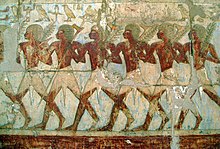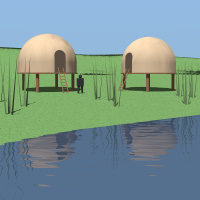ፑንት
Appearance

ፑንት (ፕወነት)[1] ከጥንታዊ ግብጽ ጋራ ንግድ ያካሄድ የነበረ ሀገር ነበር። ግብጻዊ ተጓዦችና መርከበኞች ከዚያ ወርቅ፣ ሙጫ፣ ቆጲ፣ የዝሆን ጥርስ፣ ባርያዎችና አውሬዎች ያመጡ ነበር። ፑንት ደግሞ አንዳንዴ «ታ ነጨር» (ሀገረ አምላክ) ይባላል።[2]
ፑንት በቀይ ባሕር ዳርቻ ወይም በአፍሪቃ ወገን[3] ወይም በአረቢያ ወገን[4]ወይም ምናልባት በሁለቱም እንደ ተገኘ ይታሰባል።
በአንዳንድ ዘመናዊ መምህሮች ዘንድ ፑንት ከፉጥ (የካም ልጅ) ጋር መታወቂያ ሊኖረው ይችላል።[5]በተለመደው ልማድ ግን ይህ ፉጥ በቀይ ባሕር አካባቢ ሳይሆን በሊብያ ነበር የሠፈረው።

- 2003 ዓክልበ. ግድም - የ3 መንቱሆተፕ አለቃ ሃኑ የፑንት ጉዞ መራ።[7]
- በ1 ሰኑስረትና 2 አመነምሃት ዘመኖች (1972-1905 ዓክልበ.) ደግሞ ጉዞዎች ወደ ፑንት ሄዱ።[8] በዚህ ዘመን ሥነ ጽሑፍ መርከቡ የጠፋበት መርከበኛ ተረት ፑንትን ይጠቅሳል።
- 1478 ዓክልበ. ግድም - ንግሥት ሃትሸፕሱት ቋሚ የንግድ መርከቦች ኃይል አሠራች።[9] በመቃብርዋ ግድግዳ የአምሥት መርከቦች ጉዞ ይዘገባል።[10] የሃትሸፕሱት ተልእኮ ኔህሲ በፑንት ሲደርስ የፑንት መሪዎች ንጉሥ ፓራሁ እና ንግሥት አቲ[11] ሰላምታ ሰጡት።[10]«ፑንት» የሚለው ሥያሜ በግብጽኛ ከጥንታዊ መንግሥት መዝገቦች ከ1500 ዓመታት በፊት የተወረሰ ነበር እንጂ ኗሪዎቹ ያንጊዜ አገራቸውን «ፑንት» እንዳሉት አይሆንም። ግብጻውያን ዕጣን፣ ቆጲ፣ ከብት፣ ዝሆን ጥርስ ወዘተ. ከፑንት ገዙ።[12]
- የሃትሸፕሱት ተከታዮች 3 ቱትሞሲስና 3 አመንሆተፕ ደግሞ የፑንት ንግድ አከታተሉ።[13]
- እስከ 1150 ዓክልበ. ግድም ድረስ በ3 ራሜሰስ ዘመን የፑንት ጉዞ ይዘገባል።[14]
ከፑንት የተገኙት አውሬዎች ቀጭኔ፣ አንኮ፣ ጉማሬ እና ነብር ስለ ሆኑ፣ ከዚያም በላይ የንግድ ዕቃ ዞጲ እና የዝሆን ጥርስ ሆኖ፣ አብዛኛው ሊቃውንት ፑንት በተለይ በአፍሪቃዊው ዳርቻ ላይ መሆኑን ያስቡታል።[15][16][17][18]
ከፑንት የደረሰ አንድ የአንኮ አስካሬን ቅርስ በግብጽ ተገኝቶ፣ በ2002 ዓ.ም. ሊቃውንት የጄኔቲክ ምርመራ አድርገው አንኮው በተለይ ከኤርትራና ኢትዮጵያ አንኮዎች ጋራ እንደ ተዘመደ አስታወቁ።[19]
«ፕወነት» በግብጽኛ አጻጻፍ |
 የፑንት ጎጆ በግድግዳ እንደ ተቀረጸ |
 የፑንት ጎጆዎች - ዘመናዊ አስተያየት |
- ^ Ian Shaw & Paul Nicholson, The Dictionary of Ancient Egypt, British Museum Press, London. 1995, p.231.
- ^ Breasted, John Henry (1906–1907), Ancient Records of Egypt: Historical Documents from the Earliest Times to the Persian Conquest, collected, edited, and translated, with Commentary, p.433, vol.1
- ^ Simson Najovits, Egypt, trunk of the tree, Volume 2, (Algora Publishing: 2004), p.258.
- ^ Dimitri Meeks – Chapter 4 – “Locating Punt” from the book Mysterious Lands by David B. O'Connor and Stephen Quirke
- ^ Sadler, Jr., Rodney (2009). "Put". In Katharine Sakenfeld. The New Interpreter's Dictionary of the Bible 4. Nashville: Abingdon Press. pp. 691–92.
- ^ Breasted 1906–07, p. 161, vol. 1.
- ^ Breasted 1906–07, pp. 427–433, vol. 1.
- ^ Joyce Tyldesley, Hatchepsut: The Female Pharaoh, Penguin Books, 1996 hardback, p.145
- ^ Dr. Muhammed Abdul Nayeem, (1990). Prehistory and Protohistory of the Arabian Peninsula. Hyderabad. ISBN.
- ^ ሀ ለ Tyldesley, Hatchepsut, p.149
- ^ Breasted 1906–07, pp. 246–295, vol. 1.
- ^ Tyldesley, Hatchepsut, p.147
- ^ Tyldesley, Hatchepsut, pp.145–146
- ^ K.A. Kitchen, Punt and how to get there, Orientalia 40 (1971), 184–207:190.
- ^ Shaw & Nicholson, p.231
- ^ Tyldesley, Hatchepsut, p.147
- ^ Pankhurst, Richard (2001). The Ethiopians: A history. ISBN 978-0-631-22493-8. http://books.google.com/books?id=jcpQqkHr328C&printsec=frontcover#PPA13,M1.
- ^ Hatshepsut's Temple at Deir El Bahari By Frederick Monderson
- ^ Owen Jarus ,"Baboon mummy analysis reveals Eritrea and Ethiopia as location of land of Punt". The Independent (26 April 2010). በ26 April 2010 የተወሰደ.
- Bradbury, Louise (1988), "Reflections on Travelling to 'God's Land' and Punt in the Middle Kingdom", Journal of the American Research Center in Egypt 25: 127–156, doi:10.2307/40000875
.
- Breasted, John Henry (1906-1907), Ancient Records of Egypt: Historical Documents from the Earliest Times to the Persian Conquest, collected, edited, and translated, with Commentary, 1–5, University of Chicago Press
.
- Fattovich, Rodolfo. 1991. "The Problem of Punt in the Light of the Recent Field Work in the Eastern Sudan". In Akten des vierten internationalen Ägyptologen Kongresses, München 1985, edited by Sylvia Schoske. Vol. 4 of 4 vols. Hamburg: Helmut Buske Verlag. 257–272.
- ———. 1993. "Punt: The Archaeological Perspective". In Sesto congresso internazionale de egittologia: Atti, edited by Gian Maria Zaccone and Tomaso Ricardi di Netro. Vol. 2 of 2 vols. Torino: Italgas. 399–405.
- Herzog, Rolf. 1968. Punt. Abhandlungen des Deutsches Archäologischen Instituts Kairo, Ägyptische Reihe 6. Glückstadt: Verlag J. J. Augustin.
- Kitchen, Kenneth (1971), "Punt and How to Get There", Orientalia 40: 184–207
- Kitchen, Kenneth (1993), "The Land of Punt", in Shaw, Thurstan; Sinclair, Paul; Andah, Bassey et al., The Archaeology of Africa: Foods, Metals, Towns, 20, London and New York: Routledge, pp. 587–608
.
- Meeks, Dimitri (2003), "Locating Punt", in O'Connor, David B.; Quirke, Stephen G. J., Mysterious Lands, Encounters with ancient Egypt, 5, London: Institute of Archaeology, University College London, University College London Press, pp. 53–80, ISBN 1-84472-004-7
.
- Paice, Patricia (1992), "The Punt Relief, the Pithom Stela, and the Periplus of the Erythean Sea", in Harrak, Amir, Contacts Between Cultures: Selected Papers from the 33rd International Congress of Asian and North African Studies, Toronto, 15–25 August 1990, 1, Lewiston, Queenston, and Lampeter: The Edwin Mellon Press, pp. 227–235
.
- O'Connor, David (1994), Ancient Nubia: Egypt's Rival in Africa, University of Pennsylvania Press, pp. 41–44.
- Johannes Dumichen: Die Flotte einer ägyptischen Königin, Leipzig, 1868.
- Wilhelm Max Müller: Asien und Europa nach altägyptischen Denkmälern, Leipzig, 1893.
- Adolf Erman: Life in Ancient Egypt, London, 1894.
- Édouard Naville: "Deir-el-Bahri" in Egypt Exploration Fund, Memoirs XII, XIII, XIV, and XIX, London, 1894 et seq.
- James Henry Breasted: A History of the Ancient Egyptians, New York, 1908.
- The Land of Punt with quotes from Breasted (1906) and Petrie (1939)
- Queen Hatasu, and Her Expedition to the Land of Punt Archived ሜይ 6, 2023 at the Wayback Machine by Amelia Ann Blanford Edwards (1891)
- Deir el-Bahri: Mortuary Temple of Hatshepsut
- Hall of Punt at Deir el-Bahri; and Where was Punt? discussion by Dr. Karl H. Leser
- Queen of Punt syndrome
- Archaeologists discover ancient ships in Egypt (Boston University Bridge, 18 March 2005). Excavations at Wadi Gawasis, possibly the ancient Egyptian port Saaw.
- Remains of ancient Egyptian seafaring ships discovered (New Scientist, 23 March 2005).
- Sailing to distant lands Archived ሴፕቴምበር 23, 2012 at the Wayback Machine (Al Ahram, 2 June 2005).
- Ancient ship remains are unearthed (Deutsche Press Agentur, 26 January 2006).
- 4,000-year-old shipyard unearthed in Egypt (MSNBC, 6 March 2006).
